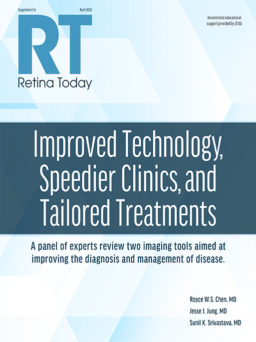Dr. Wykoff: There is some variation in how we are all using imaging at this point and time, but a common theme that emerges from our discussion is that imaging studies can change how we treat, when we follow-up, or both. What is your threshold to start treatment? In the absence of proliferative disease, is DR progression an indication that treatment is needed?
Dr. Coney: I have started to move toward earlier treatment of DR, even NPDR, because in this day and age, with the effectiveness of anti-VEGF therapy, there is no reason why anyone should go blind from diabetes if they are diagnosed early and treated properly. I see anti-VEGF therapy as a way to turn back the hands of time: if I can decrease the level of retinopathy, there is less chance of progression, and if it does occur, it will be slower. Another way I have heard this concept described is the “slowing the train analogy.” We are not going to stop DR dead in its tracks with a single anti-VEGF injection, but over time, we slow the train and hopefully stop it before it goes off the track.
Dr. Kiss: I will only offer treatment if there are abnormal blood vessels, which relates back to our discussion on the use of FA. If there is even a hint of proliferation on clinical exam or Optos imaging, I will obtain an FA, regardless of the level of diabetic control. If the proliferation is confirmed, I treat, and if not but there is some ischemia, I want the patient to return in 2 to 3 months.
Dr. Baumal: PDR is definitely an indication to start treatment. However, there may be selected situations where one may consider treatment for severe nonproliferative disease—for example, if the patient is monocular, if the fellow eye had rapidly progressive DR with a poor outcome, or if there are concerns regarding compliance with follow-up. There is a need to evaluate treatment of DR on a case-by-case basis overall, taking into account the unique circumstances of each patient.
Dr. Coney: Diabetes is multifactorial. Although the risk factors for progression are well known, we still cannot predict who will progress, which makes me more willing to have a conversation with patients about anti-VEGF therapy. A year ago, if I had a patient with an ischemic retina and peripheral neovascularization, I probably would have opted for laser. Now, if the patient is going to be compliant with the follow-up protocol, I would prefer to offer anti-VEGF injections and use laser adjunctively.
Dr. Kiss: I am not sure that laser is the answer to noncompliance. The Diabetic Retinopathy Clinical Research Network (DRCR.net) Protocol S study may be the closest we have to objective data on the potential role of laser in this setting. But even in that study, while most patients in the PRP group received only one laser session, the average was 2.5 in year 1, and on top of that, 60% of those patients required anti-VEGF therapy by the end of the study.3,4 In fairness, some of those injections were for development of DME. But the point is, there is still a treatment burden associated with laser, and pharmacotherapy may still be necessary. Bottom line, a noncompliant patient is almost assuredly going to lose vision, and laser is an ineffective way to manage compliance.

